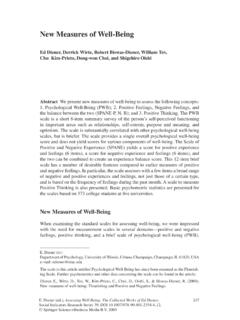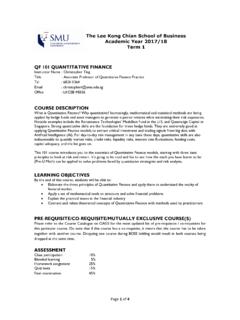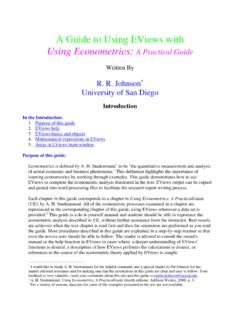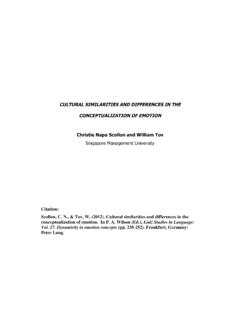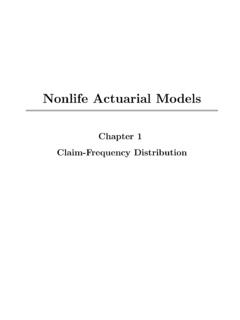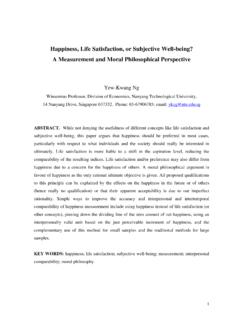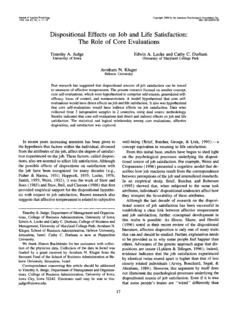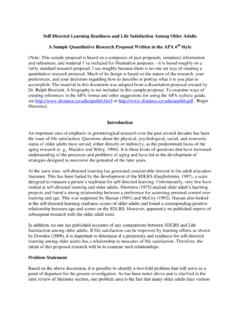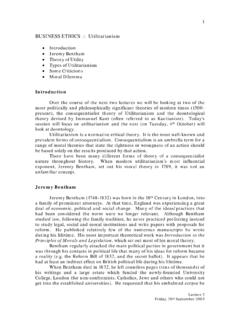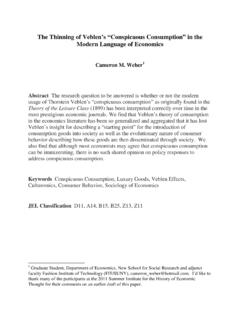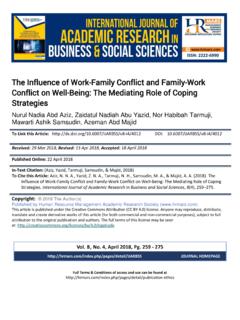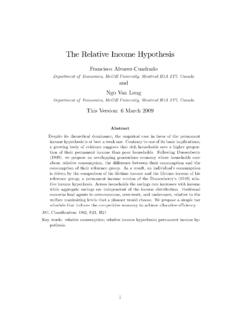Transcription of Culture and Subjective Well-Being - mysmu.edu
1 Subjective well -BEING1 Running head: Subjective well -BEINGC ulture and Subjective well -BeingWilliam TovUniversity of IllinoisEd DienerUniversity of Illinois and the Gallup OrganizationCitation:Tov, W., & Diener, E. (2007). Culture and Subjective Well-Being . In S. Kitayama & (Eds.),Handbook of cultural psychology(pp. 691-713). New York: well -BEING2 AbstractSubjective Well-Being (SWB) is composed of people s evaluations of their lives,including pleasant affect, infrequent unpleasant affect, life satisfaction (LS). We review theresearch literature concerning the influence of Culture on SWB. We argue that some types ofwell-being, as well as their causes, are consistent across cultures, whereas there are also uniquepatterns of Well-Being in societies that are not comparable across cultures. Thus, Well-Being canbe understood to some degree in universal terms, but must also be understood within theframework of each Culture .
2 We review the methodological challenges to assessing SWB indifferent cultures. One important question for future research is the degree to which feelings ofwell-being lead to the same outcomes in different cultures. The overarching theme of the paperis that there are pancultural experiences of SWB that can be compared across cultures, but thatthere are also Culture -specific patterns that make cultures unique in their experience of well -BEING3 Introduction With great perseveranceHe meditates, seekingFreedom and happiness. -- fromThe DhammapadaOver two thousand years ago, the Buddha perceived suffering to be the nature ofexistence. But for him, the attainment of nirvana was not simply a break from this cycle ofsuffering, it was also a return to true bliss. Although it was not the direct purpose of meditation,happiness was certainly an important consequence, and a critical topic in Buddhist philosophy(Gaskins, 1999).
3 Across time and cultures, generations of people have in their own wayreflected upon the question of happiness. As long as it has been pondered, it may come as asurprise that the scientific study of happiness, or Subjective Well-Being (SWB; E. Diener, 1984)has advanced only of the challenges has been defining happiness in a way that enables it to bemeasured. Given that conceptions of happiness may vary across different societies, a number ofquestions arises regardinghowculture influences the idea and experience of happiness. Does thestructure and content of SWB differ? Do certain cultures emphasize some components morethan others? Are the correlates and causes of happiness similar across cultures? Do people reactdifferently to the experience of Well-Being ( , when they feel pleasant affect)?As it has been studied over the past two decades, SWB involves frequent pleasantemotion, infrequent unpleasant emotion, and life satisfaction (LS).
4 The first two components areaffective; the last is a cognitive evaluation. These three components are not the only elements ofSWB. Happiness also can be said to consist of other dimensions such as meaning and purpose inlife. However, in this review we focus on LS, pleasant affect, and unpleasant affect in partbecause these constructs have been researched more frequently across cultures. Furthermore, Subjective well -BEING4these components of SWB are major focal points that allow for a certain degree of precision inmeasuring the fuzzier, folk concept of Study SWB Across Cultures?The cross-cultural study of SWB is one indicator of the quality of life in a society. It wasonce considered taboo to suggest that societies could be evaluated at all (Shweder, 2000). Toappraiseanyaspect of a Culture was to ignore its worth and integrity. However, this extremeform of cultural relativism has given way to the view that, though one must be careful incomparing and evaluating societies, they may differ in variables such as health and satisfactionthat are desirable in most cultures.
5 It is true that some indicators of life quality may imposevalues about the good life that are not shared by all people. However, even if SWB is internallyframed with respect to each Culture , societies could still be evaluated in terms of how well theysucceed according to these internal and SWB research can also shed light on basic emotional processes. Inmeasuring SWB across various societies, researchers have confronted issues regarding theuniversality of emotions, and how the representation of emotions in memory are influenced bycultural norms. The field can also add to our understanding of Culture . For example, how docultures differ in their socialization of pleasant and unpleasant affect, and how do emotionscontribute to the reinforcement of cultural values and practices? These questions reflect acultural psychological perspective. Thus, the topic is of both applied and theoretical of this Field of InquiryAnthropologists adopted cultural relativity as a way of avoiding a Western, ethnocentricbias in observing other cultures.
6 They made the important observation that values and practicesmight vary across cultures, but this need not imply that some cultures were necessarily betterSUBJECTIVE well -BEING5than others. In particular, we should avoid judging other cultures by the standards of our , taken to extremes, cultural relativism would prevent one from saying that NaziGermany, or Cambodia under the Khmer Rouge, were in many respects undesirable cultures(Edgerton, 1992). This level of extreme value relativity would make cultural psychologyirrelevant to public discourse. According to Edgerton (1992), not all practices in a Culture areadaptive; some may even be harmful. He defined maladaptive cultures as those in which therewas rampant dissatisfaction or impaired physical and mental health. Thus, there are certaincriteria by which we can judge the success of a Culture .
7 As one such criterion, SWB is importantbecause a society functions poorly when a majority of its people are discontent and should be noted that very little quantitative work has examined the Well-Being of smallcultures ( , Biswas-Diener, Vitters , & Diener, 2003), although a number of internationalsurveys of SWB in modern nations have been conducted ( , Cantril, 1965; Inglehart, 1990; seeTable 1). Only recently has research examined the structure and causes of SWB in differentcultures. In 1995, for example, E. Diener and Diener found that self-esteem correlatedmore strongly with LS in individualist than in collectivist cultures, and that financial satisfactionmore strongly predicted LS in poor than in rich nations. Since then, there has been a rapidgrowth in the field of Culture and Well-Being , and both universal and unique correlates of SWBhave been documented.
8 We foresee further growth in this research area in the decade to Approaches to Cross-Cultural Comparisons of SWBThe comparisons that researchers make across cultures are guided by their assumptionsabout the interplay between Culture and SWB. We review some of these approaches well -BEING6 Dimensional ApproachSome theorists hold that the causes of Well-Being are fundamentally the same for allpeople. Ryff and Singer (1998) posited that purpose in life , quality relationships, self-regard,and a sense of mastery were universal features of Well-Being . Self-determination theorists (Deci& Ryan, 1985; Ryan & Deci, 2000) maintain that Well-Being hinges on the fulfillment ofinnatepsychological needs such as autonomy, competence, and relatedness. If these sources of Well-Being are universal, they provide dimensions along which we can compare societies.
9 Culturesshould differ in SWB to the extent that they provide people with different levels autonomy,meaning, and related perspective is the universalist position on emotions. Drawing on diversefindings, some researchers propose that there are discrete, basic emotions that appear in allcultures (Ekman & Friesen, 1971; Izard & Malatesta, 1987; Plutchik, 1980; Tomkins, 1962,1963). For example, facial expressions of anger, sadness, and joy appear early in infancy (Izard& Malatesta, 1987), and are easily recognized in many different cultures (Ekman & Friesen,1971; Ekman et al., 1987). Facial expressions of laughing and crying among congenitally blindinfants (Thompson, 1941) suggest that there may be genetic programs directing the expression ofemotions. The possibility of biologically based, basic emotions is important for it implies thatwe can compare people across societies on these emotions (however, see Ortony & Turner, 1990for a critique of the basic emotions concept).
10 Uniqueness ApproachIn contrast to the universalist approach, some ethnographers emphasize emotions associal constructions. According to these researchers, the very concept of emotion may differacross cultures. Lutz (1988) noted that Western ethnopsychologies often view emotions asSUBJECTIVE well -BEING7hidden and private. In contrast, her work in Micronesia revealed that Ifalukian concepts ofemotions were more public and relational. Cultures may also differ in their labeling of specificfeelings. For example, according to Wierzbicka (1986) there is no word for disgust in versions of the uniqueness approach hold that emotions are purely a Western idea, andthat internal experiences can be represented in countless ways across cultures. More moderateformulations, on the other hand, maintain that biologically based emotions may be universal, butthat Culture can significantly alter their development and labelling.
